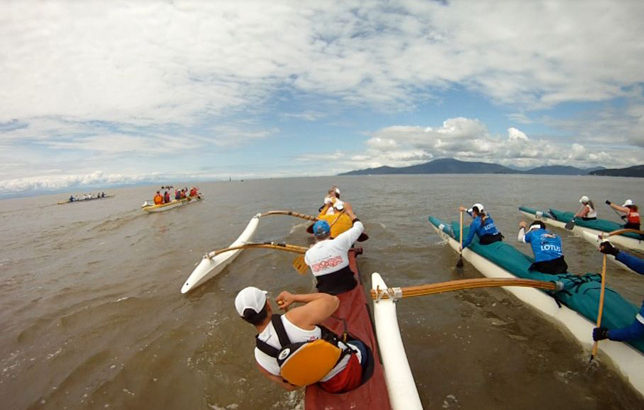Safety is everyone’s responsibility, all the time. It’s not just the Captain’s job.
If in doubt, don’t go out.
Let a friend or family member know you are going out for a paddle, where you are going and when you expect to be back on shore. Follow-up with an after paddle phone call.
Check the boat EVERY time it goes out. Bailers? Lashings tight and in good condition? Bulkheads and Ama watertight and fitted with proper plugs.
Check the local weather conditions: Wind speed and direction, air/water temperature, tides, currents, fog? What is the forecast? What time does the sunset?
Your PFD needs to fit properly and be approved by Transport Canada – check the label. More and more venues are requiring APPROVED PFD’s. – IT WORKS WHEN YOU WEAR IT!
Most approved PFD’s have a pealess whistle attached. Have one. Tuck a wool or fleece cap in your PFD’s pocket.
Ask if everyone in the boat can swim. Non swimmers should wear PFD’s all the time. The rest of the team needs to know and have a plan.
Hypothermia can occur from rain, wind, splashing water, not just hulis. Be prepared. Take a small dry bag with a jacket and hat, even in the summer.
Glare off the water can damage eyes as well as skin. Wear shades, have a light long sleeved shirt in the summer, wear a ball cap.
Review your huli drill regularly. Who does what? Buddy count? Paddles? Bail?
Inform your coach, steersperson/captain of any health issues or medications that may affect your attention or performance.
Cold water saps your body’s core heat much faster than air. If you can’t get out of the water, use the Heat Escape Lessening Position (HELP). With PFD on, cross arms tightly, draw knees up close to chest, remain calm and still. If more than one person , all huddle and hold on to each other.
If you see a dark line on the horizon, it’s the wind and/or tide.The darker the line, the stronger the wind. Be aware of it and head back if necessary.
The Number One cause of hulis is a lack of communication. Seat 5 and 6 must work together, especially when wind on the Ama side or quarter. If you are calling the changes, call when the boat is ‘Safe’, not just on an agreed number of strokes.
Recreational boats, including canoes and kayaks, account for more than 50% of Search and Rescue Incidents, over 3,500 incidents annually. Prevention is better than Cure.
Not having an APPROVED PFD that is an appropriate fit and in good condition, in most Provinces, could cost you $200 for each violation.
Stupid Risk and Smart Risk – know the difference. Stupid Risk is not taking/wearing PFD’s, not looking over your shoulder before you turn, paddling under the influence or hung over, not learning how to read a chart or recognize Aids to Navigation….
Lateral Buoys depend on the ‘Upstream Direction” system. Upstream is ‘from seaward toward the headwaters of a river, into a harbour, or with the flood tide (in that order). In general, it is a northerly direction along the Pacific Coast. Remember RED RIGHT RETURNING. Keep the Red buoys or daymarks on the Right side when returning to harbour (upstream Direction). Cardinal Buoys depend on reference to the cardinal points of the compass.
Putting a PFD on while you’re in the water is almost impossible. Put your PFD on before entering the water or have a buddy help you if you are already in the water.
Two big waves can swamp a canoe! If you are paddling in big or unpredictable waters, make sure you are using a spraydeck, and that it is in good shape.
An experienced crew’s playground is a huli waiting to happen for inexperienced paddlers. In the 2005 Island Iron, the race organizers let the first six crews go, then redirected the rest of the pack to a safer, shorter course. Everyone had a great day racing!
CORA’s Comprehensive Safety Manual located on the Resource Page, is available for use by all CORA Clubs
Enclose your fully charged cell phone in two sealed sandwich bags and keep on your person. In the event of a sea disaster you can’t solve yourself, dialing *311 will put you in touch with the Canadian Coast Guard’s Rescue Coordination Centre.
Don’t go farther from shore than you care to swim back if you or your equipment should fail.
Visit the Cold Water Boot Camp website for resources on how to reduce or prevent the risk of Cold Water Immersion.
Consider acquiring a low-cost emergency/disposable prepaid cell phone and carrying this “burner phone” in a waterproof container for additional paddling safety.
Some event organizers have instituted a rule whereby all event participants must carry a tow-line on their OC6 and must know how to fasten this tow-line to a support boat. See this SCORA Video on how to properly attach a towline to a swamped canoe.
Learn where to attach a towline to the OC6 and how to ready the towline for attachment to a rescue boat. See this Incident at Pailolo where a crew did not properly attach a towline to a swamped OC6 and the OC6 drifted away to eventually wash ashore.
Dr. Popsicle in his Cold Water Boot Camps emphasizes the importance of keeping everyone together to increase the chances of survival. See this article on what can happen when the crew does not stay together.
When multiple canoes are out together, consider having the lead canoe circle back to lookout for trailing canoes so that nobody gets left behind.
Most crews/paddlers usually do huli practices in calm conditions. Consider huli practices in windy/choppy conditions, as this is where OC6 or small-boat paddlers may find themselves caught off-guard by turbulent water.
